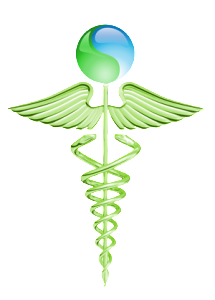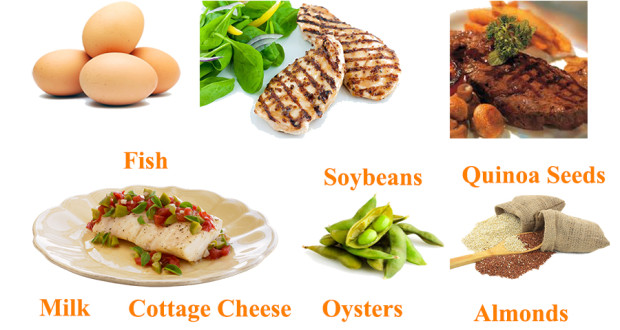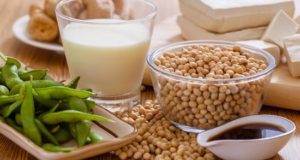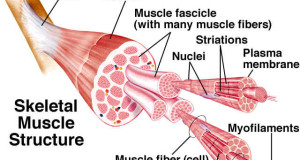
What are Proteins?
Proteins are complex molecules; they consist of linked amino acids. A protein is a “macronutrient,” meaning that the body needs relatively large amounts in order to function efficiently. Protein is the most vital macronutrient because it builds and maintains the entire body structure. The body is not able to utilize all protein at one time. The unused protein is converted to carbohydrates and used immediately for energy, or it is stored as fat. The body does not store protein; therefore, it has no reservoir to draw on when it needs a new supply. For example, if an individual consumes a lot of protein on Monday, it is not available on Tuesday. The protein consumed at breakfast is pretty much used up by dinner time. Proteins are the basic elements of all animal tissue; in addition, about 17% of our bodies consist of proteins. At least 10,000 different proteins make each person who they are and keep them that way. Because muscles are built from protein, people need to consume and synthesize enough protein to maintain healthy, hard-working muscles. The body is unable to use food protein directly, even though the amino acids in food and in the body are the same. Protein is ingested; then, digestive enzymes break the protein down into shorter amino acid chains (polypeptides and then peptides), and finally into individual amino acids. The amino acids then enter the blood stream and travel to the cells where they are incorporated into proteins the body needs.
Benefits
Proteins form the body’s main structural elements, and are found in every cell and tissue. Some of the benefits received from protein consumption include the following:
– Growth and development
– Tissue repair: Protein is the only macronutrient that promotes lean tissue growth.
– Protects immune function
– Aids in digestion process
– Energy source: When carbohydrates and fats are unable to meet the body’s energy needs, proteins can be broken down and used as a source of emergency energy.
– Produces essential hormones and enzymes: Protein assists in synthesizing enzymes and hormones, maintaining fluid balance, and regulating such vital functions as building antibodies against infection, blood clotting, and scar formation. Proteins also help formulate enzymes the body utilizes to send messages that provide a person with the ability to see, think, hear and move.
– Healthy functions: Protein promotes healthy bones, teeth, skin, hair, nails.
Food Sources
Proteins that are found in foods that supply enough of the essential amino acids are known as complete proteins; if not, it is an incomplete protein. The protein content of cooked meat and dairy products is from 15% to 40%, and that of cooked cereals, beans, lentils, and peas only from 3% to 10%. All meat and other animal products are sources of complete protein. For example: beef, lamb, pork, poultry, eggs, fish, shellfish, milk and milk products, vegetable dietary protein sources. Plant foods contain the same amino acids as animal foods, but in different amounts. Protein in foods such as most grains, fruits, and vegetables are considered incomplete proteins, being either low in, or lacking, one of the essential amino acids. Plant protein sources can be combined with other plant or animal products to form a complete protein; examples include the following: rice and beans, milk and wheat cereal, corn and beans. Plant foods that are considered complete proteins include nuts, soy foods (tofu, tempeh, miso, and soy milk), sprouted seeds (each type of sprout differs in nutrient proportions, consume a variety), grains (especially amaranth and quinoa, highest in protein), beans and legumes, (especially when eaten raw), spirulina and chorella or blue-green algae (over 60% protein).
Amino acids make up proteins. There are about 20 amino acids that are the building blocks of protein. These amino acids build DNA, cell membranes, hormones, receptors, brain chemicals, and many other molecules in the body. Both the amino acids manufactured in the liver and those derived from the breakdown of the proteins we eat are absorbed into the blood stream and are taken up by the cells and tissues to build new proteins as needed. Nine of the twenty amino acids required by human beings are considered “essential” because they come only from the individual’s nutrition plan; the other 11 are considered “nonessential” because the body can make them. A complete protein contains all the essential amino acids in amounts necessary for the body.
There are nine amino acids that are essential for your health. They are essential because your body is unable to produce them on its own. They consist of the following:
– Isoleucine
– Leucine
– Lysine
– Methionine
– Phenylalanine
– Threonine
– Tryptophan
– Valine
– Histidine
Non-essential amino acids can be made from the essential amino acids.
Other necessary amino acids include:
– Arginine
– Cystine
– Glutamine
– Glycine
– Proline
– Tyrosine
– Alanine
– Aspartic Acid
– Hydroxyproline
– Serine
Protein Intake
Everyday, the body uses more protein than one is able to intake; therefore, the body needs to continuously consume enough proteins to maintain a healthy lifestyle. If the body does not obtain enough proteins through food, the individual will begin to start using proteins in the body, including muscle proteins. As a healthy rule, consuming 20%-35% of an individual’s total nutritional calories should come from protein.
When maintaining a healthy lifestyle, consuming approximately .5 grams of protein per body weight is suggested. For example, if an individual weighs 150 pounds, they should consume 75 grams of protein from their total calorie intake.
Increasing the amount of protein intake is necessary when an individual is trying to gain muscle mass and size. An individual weighing 150 pounds should be consuming 1.0 to 1.5 grams of protein from their total calorie intake. Therefore, protein consumption should be approximately 150 to 225 grams of protein. Maintaining a high protein nutritional plan for long periods can cause unhealthy medical conditions. Consequently, when looking to increase muscle size, creating a nutritional plan high in protein should be cycled on and off to allow the body time to recover from the increased protein intake. High protein intake overtime can cause liver and kidney disease, which causes your body to inefficiently process proteins.
Whether a person is an avid strength trainer, a marathon runner, or just an average exerciser, a balanced diet that is rich in fruits, vegetables, whole grains, lean meats, fish, and complex carbohydrates is what nutritionists recommend.
Protein Deficiency
Most Americans consume more than enough protein in their daily nutritional plans. A protein deficiency is defined as eating 50% to 75% of the recommended amount of daily protein. When an individual does not consume enough protein, his or her body becomes deficient; much like it does for other micronutrients. The first sign of protein deficiency is weak muscles. Protein plays an important role in developing strong muscles. White spots on nails and brittle hair are often good indicators of protein deficiency. Serious deficiencies can lead to consequences for the body: these include muscle deterioration and wrinkling of the skin.

Source by Robert C. Fisher
 Vitamin Agent The Health & Naturalistic Source
Vitamin Agent The Health & Naturalistic Source





